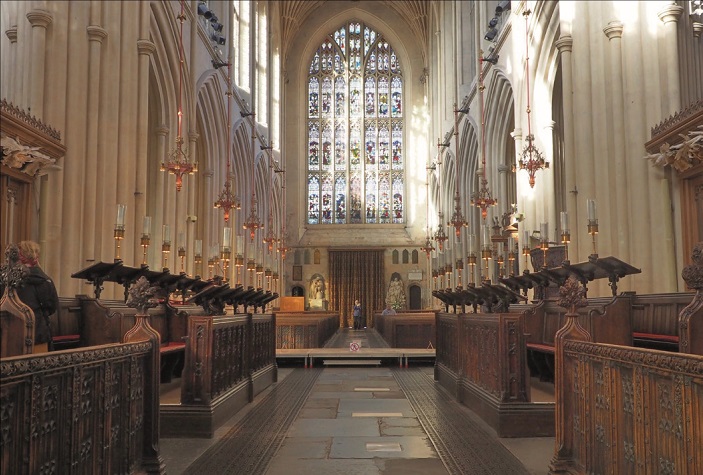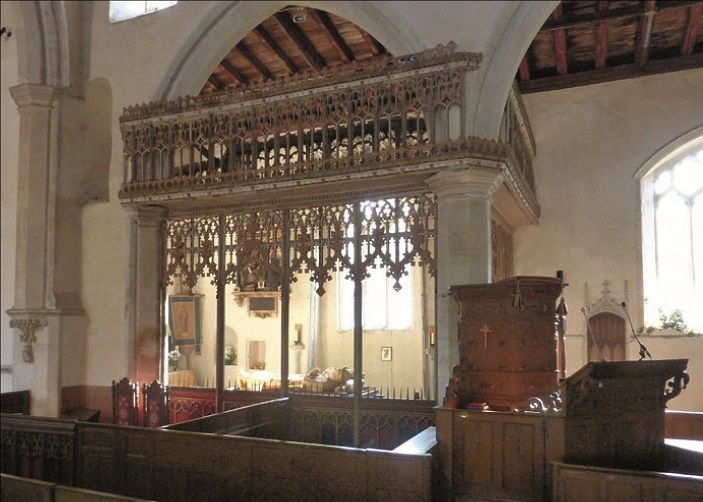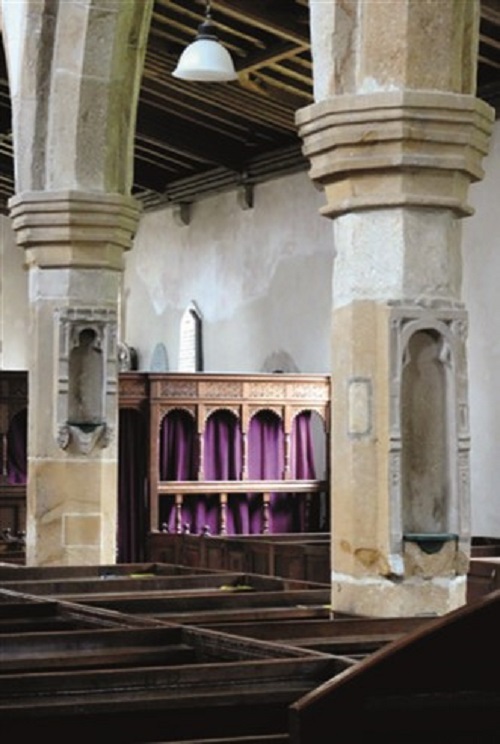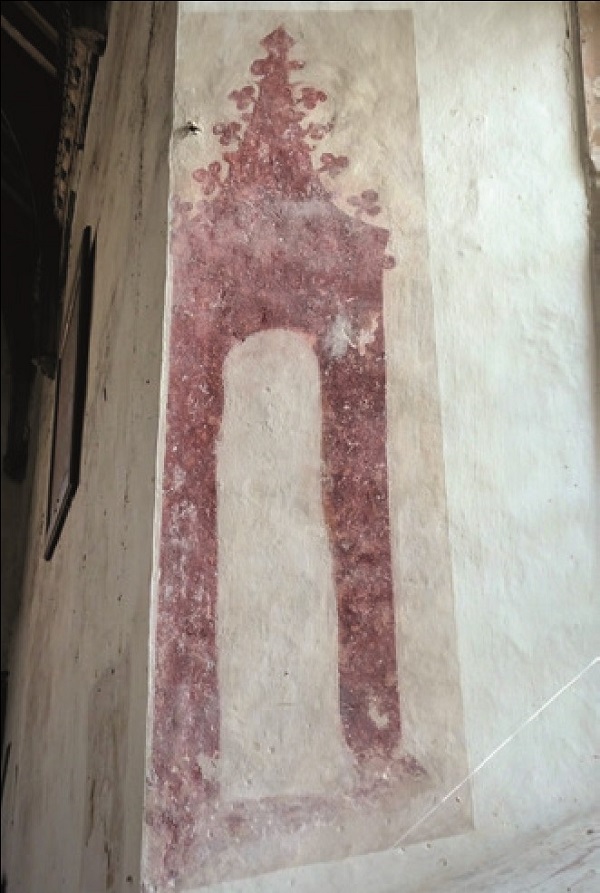Sacred or Secular
The Use of the Nave in Medieval Parish Churches
Richard Halsey
 |
||
| To allow its nave to be used more flexibly, Bath Abbey was granted a faculty in 2017 for the removal of many of its Victorian pews, despite the objections of the Victorian Society and others. (Photo: Jonathan Taylor) |
Since the launch of Building Faith in our Future in 2004, the Church of England has been promoting the use of parish churches for all sorts of non-worship purposes, even allowing the sub-division of interiors to produce a commercial rent (usually from charities). The Taylor Review (published December 2017) took this a step further by linking varied community use to sustainability. While a precise definition of sustainability is still to be seen (and will presumably emerge from the Taylor Pilot scheme now in progress in Greater Manchester and Suffolk), the financial significance of community use is clear. While it is broadly accepted that public funding cannot be used to support worship-related activities or the promulgation of a particular faith, community-based activities of a faith group are far less contentious. Many do extraordinary works and can attract public funding, but should such uses become a pre-requisite for any historic church wishing to benefit from future government-funded repair grant schemes?
As Roman Catholics adhere to the ancient doctrine that a church building is a sacred space and not to be used for non-worship uses, a more nuanced measure of sustainability will be needed for their churches, as well as for the places of worship of like-minded Christians and faiths. They usually have dedicated halls, meeting rooms or separate spaces adjacent to the worshipping area for social, eating and educational use, as well as for toilets and ritual ablutions.
For the Church of England at least, the creation of pew-free flexible space with kitchens and toilets in pre-20th-century church buildings is frequently justified to chancellors, diocesan advisory committees (DACs) and donors as ‘bringing back the original community use’ and, particularly, returning the nave to its use in the Middle Ages as the village hall. However, this interpretation of how naves were used can be considered a gross simplification of what these spaces were built for and the uses they have housed, and the evidence needs to be carefully considered, particularly where re-ordering involves the loss of historic fabric.
INTERPRETING THE EVIDENCE
The association of the nave with community use was propagated (if not actually started) in 1944 by the historian GM Trevelyan in his book English Social History. He describes social events known as church ales, which were held in the church or churchyard to raise funds for building repairs, and states that ‘The nave of the church was the village hall for most communal purposes’. His suggestion was greatly supported by the publication in 1968 of JG Davies’ book, The Secular Use of Church Buildings, which quotes many documented examples of secular activities in churches across Europe, although concentrating on late medieval England.
Social upheaval and redevelopment in the mid-20th century was reflected in the rapid evolution of church architecture, liturgy and theology, and Davies’ book had a wider purpose than its dry title might suggest. He was Edward Cadbury professor of theology in the University of Birmingham but more importantly, a leading member of the university’s Institute for the Study of Worship and Religious Architecture. From his main academic research into the buildings and liturgy of the early Christians, he was convinced that church buildings should accommodate all the functions of human society and in particular eating and socialising. He brought his conclusions to the attention of the New Churches Research Group, previously set up by Canon Peter Hammond in 1957, which was determined to bring the lessons of the Liturgical Movement to bear on the design of new churches in Britain. Rapidly expanding new housing estates needed new places of worship and both the Roman Catholics and the Church of England began building hundreds of new churches as early as the 1930s. For economic rather than theological reasons, both pursued the design of multi-purpose buildings, with halls built at an angle to the church or just single spaces that could be partitioned with folding doors or heavy plastic dividers.
 |
||
| What we now consider as aisles were often sub-divided by screens into separate chapels, as at Dennington, Suffolk. Here at the east end of the nave aisle, the Bardolf chapel (c1450) retains the loft of its parclose screen and the opening in the wall to the left would have led to the rood loft. (Photo: Richard Halsey) |
These were new buildings of course and Davies’ book was really aimed at the re-ordering of the Church of England’s parish churches to make them fit for the 20th century. He found documentary evidence to prove that medieval churches housed eating and drinking, plays, dances, markets and judicial functions. According to Davies, ‘There can be no question that in the Middle Ages the church was an all-purpose building. It is difficult to think of any secular activity that has no connection with it’. It followed, then, that it was legitimate to allow medieval churches (and the Victorian churches that followed a medieval template) to do the same in future, preferably in connection with creating a worship space that encouraged congregational participation in a Eucharist, rather than merely viewing it being celebrated at a distance in the chancel. The same flexible nave worship space could be used for what we now call ‘community activities’ and although Davies didn’t specifically advocate post offices and community cafés in churches, he would surely have approved of them.
Much of Davies’ evidence came from diocesan visitation and other legal records. However, their erratic survival rate makes drawing wider conclusions about the use of medieval churches problematic (and it is not always clear whether the activities were held in the church or churchyard). Looking through one whole set only shows an occasional record of a market being held in one church, or people dancing on just one day in another. Perhaps the most widespread secular activity was the church ale, but again there is insufficient evidence that this was the norm in all churches. It would not be surprising if the only large covered space in a small village was resorted to in the winter or on a bad weather day, or that the church wardens were persuaded into such uses on occasion, for it would be the congregation and its representatives who controlled the nave, not the priest whose remit only ran in the chancel. Individuals then were just as influenced by others, or by events, or persuaded of the value of a particular argument as they are now.
Davies suggests that it was ‘only towards the end of the period under review that fixed pews on any large scale were introduced’, although he omits to mention that the great majority of his examples come from that same period. Today, it is thought probable that blocks of fixed benches, which could be viewed as evidence of dedicated worship space, were normally present in the naves of English parish churches by the end of the 15th century, but it is not at all clear when they began to be introduced. There have been claims for mid-13th-century bench ends on stylistic grounds (as they look crude), but scientific analysis of those at Dunsfold (Surrey) gave a felling date of 1409–1441. That pews replaced ad hoc stools, loose benches, cushions and perhaps types of prie-dieu is generally agreed. The growing popularity of sermons, and an increase in personal devotions is thought to be the reason for introducing permanent, more comfortable seating. Blocks of pews would clearly inhibit large scale community events like church ales, and the building of separate church houses in or against the churchyard to house such events from the mid-15th century is further evidence for their widespread introduction. As ever with changes in parish churches, there is likely to have been huge variation, involving issues of status, governance, and of course, money. Rich individuals paid for some congregational pews as well as those for their own family, and in other places, churchwardens’ accounts list payments for seating.
The principal purpose of a church building, to provide an appropriate setting for worship and religious devotion, is ignored by Davies, possibly because the hierarchical and distinctly Catholic liturgies of the Middle Ages were definitely not what he wanted to see continued. Neither does he make much of the role of guilds in creating chapels in churches (except to comment on how benches had spread from the guilds’ chapels into the body of the church, limiting the use to which it could be put). However, from the late 12th century, family chapels, and from the next century the growth of guilds and chantries, created the demand for dedicated worship space. Regardless of the parish population, it was these needs that caused the enlargement of parish churches rather than any role as a village hall. Village meetings and certainly local courts would have been held in premises owned by the owner of the manor, perhaps in the hall of a steward, reeve or bailiff’s house if not the lord’s own hall. In the later Middle Ages, church houses, guild halls and market crosses became used for formal communal activities.
HOW THE NAVE WAS REALLY USED
 |
 |
| Other surviving indicators of how the medieval church interior was subdivided by chapels and dedications to saints include niches on the nave piers at Kirkby Malham, West Yorkshire and a painted niche in a window splay at Westhall, Suffolk. (Photos: Richard Halsey) | |
What did happen in the nave then? The essential point of attending church was to witness the sacrament during the mass. The leading parish families stood or sat in the chancel (despite frequent episcopal orders to the contrary) and the next most influential people would congregate in front of the chancel screen under the rood, Christ’s figure on the cross in the chancel arch. The need for a separate Lady Chapel and for dedicated family burial space initially meant adding nave aisles or transverse chapels at the east end of the nave (often mistakenly called transepts). They were separated from the nave by parclose screens or by curtains within the arcades. The later guild chapels and chantries, each with an altar for a retained priest to celebrate mass, would have been behind partitions too. Different window designs, fragmentary wall paintings, bits of stained glass, corbels, empty niches and small piscina may be the only physical evidence of such chapels today.
Therefore, what we now call aisles were sub-divided by screens into separate chapels accessed from the nave or even their own external doors. Each patron might commission their own window giving the aisle wall varied sizes and shapes of window. Screened chapels could well leave the nave somewhat cramped and dark, which was perhaps the inducement from the 15th century to raise the arcades, add a clerestory and insert a big west window.
The growth of private devotions to favourite saints encouraged many images which have hardly survived, being targeted by Edward VI and later, the Puritans; perhaps St Christopher wall paintings, usually visible from a door, are the most common. A few paintings survive on nave arcade columns, such as Christ as the Man of Sorrows at Lydiard Tregoze (Wiltshire) or the Crucifixion at Broughton (Oxfordshire). Occasionally, small niches or just corbels can be seen (or are known to have existed); Kirkby Malham (West Yorkshire) remarkably has a niche to nearly every nave pier, each subtly different. If the nave was aisleless, then images were placed on the window splay within painted niches or on painted screens or cloths or just in the stained glass. That and any statuary have long gone and restorers have sadly stripped plaster from walls and piers. It is only documentary evidence, especially from wills, that tell us now about the existence of so many images in churches.
Membership of a guild was so important to people’s social and economic life, as well as their spiritual life, that it is true to say that the average parish church really was the hub of a community in the late Middle Ages. However, the overriding activity within a medieval church was worship and religious devotion. The provision of appropriate spaces for this to take place was the prime reason to build and enlarge a church. Non-worship activities clearly did take place somewhere inside some churches on occasion, but this was the exception and not the rule.
SEEKING JUSTIFICATION
Heritage protection favours keeping a building in its original use wherever possible, so a greater degree of alteration may be justified where a building’s viability is at stake. However, harm to the significance of any listed building must always be weighed carefully against the benefits, avoiding spurious justifications which distort this balance.
There are documented instances of a medieval church nave being used as a public space, but to suggest that all church naves were regularly used in this way over-simplifies the issue and should not be used to justify radical changes. As is normal in conservation, each case has to be considered individually and on its own merits, including defining the intrinsic benefits of contemporary uses .
Further Reading
Incorporated Church Building Society, Fifty Modern Churches, ICBS London, 1947
Incorporated Church Building Society, Sixty Post-War Churches: Churches, church centres, dual-purpose churches, ICBS London, 1956
P Cowley, The Church Houses: Their religious and social significance, London, 1970
P S Barnwell, T Cooper and S Brown (eds), ‘Seating in the nave of the pre-Reformation parish church’, Pews, Benches and Chairs: Church seating in English parish churches from the fourteenth century to the present, London, 2011



